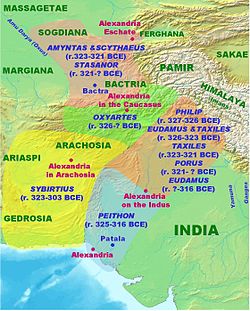Stasanor (in Greek: Στασάνωρ; lived 4th century BC) was a native of Soli in Cyprus who held a distinguished position among the officers of Alexander the Great.[1]
Stasanor, officer of Alexander[]
He probably entered the service of that monarch after the conquest of Cyprus in 333 BC, but the first occasion on which his name is mentioned is during the campaign in Bactria, when he was detached by Alexander with a strong force to reduce Arsames, the revolted satrap of Aria. This service, in conjunction with Phrataphernes, he successfully accomplished, and rejoined Alexander at Zariaspa in the autumn of 328 BC, bringing with him Arsames himself as a captive, as well as Barzanes, who had been appointed by Bessus satrap of Parthia.[2]
Stasanor the Satrap[]

Stasanor was satrap of Bactria and Sogdiana from 321 BCE.
As a reward for this exploit he obtained the satrapy of Aria, which was, however, soon after changed for that of Drangiana, in the command of which he remained during the whole of Alexander's campaign in India. On the king's return, Stasanor was one of those who met him in Carmania with a very opportune supply of camels and other beasts of burden, but returned to resume the charge of his province when Alexander continued his march towards Persis.[3] In the first partition of the provinces after the death of Alexander (323 BC), Stasanor retained his former satrapy of Drangiana, but in the subsequent division at Triparadisus (321 BC), he exchanged it for the more important government of Bactria and Sogdiana.[4] Here he appears to have remained quiet for some years, taking no open part, so far as we are informed in the contest between Eumenes and Antigonus. After the victory of Antigonus, although Stasanor had apparently inclined in favour of Eumenes, Antigonus found it prudent to pardon him and left him in the undisturbed possession of his satrapy, 316 BC.[5], since Stasanor had secured the attachment of the native population by the justice and moderation of his rule, and thus firmly established his power in the satrapy.
Fate[]
From this time his name does not appear again in history. Justin however explains that around 305 BCE Seleucus attacked and conquered Bactria, probably in a conflict with Stasanor or possibly his successor:
- "Seleucos made many wars in the Orient after the division of the Macedonian kingdom between allies. At the beginning, he took Babylon; from there, his strengths increased by victory, he took over the Bactrians. He then went to India, which, after the death of Alexander, had assassinated his prefects, as if shaking the burden of servitude" Justin XV.4 [6]
Connections[]
He was a contemporary and compatriot of Clearchus of Soli (born in the same city of Soli, in Cyprus), a peripatetician philosopher who was seemingly involved in the foundation of the Bactrian city of Alexandria on the Oxus.
References[]
- Smith, William (editor); Dictionary of Greek and Roman Biography and Mythology, "Stasanor", Boston, (1867)
Notes[]
| Constructs such as ibid., loc. cit. and idem are discouraged for footnotes, as they are easily broken. Please improve this article by replacing them with named references, or an abbreviated title. (October 2014) |
- ↑ Strabo, Geography, xiv. 6
- ↑ Arrian, Anabasis Alexandri, iii. 29, iv. 7
- ↑ Ibid., iv. 18, vi. 27, 29; Curtius Rufus, Historiae Alexandri Magni, viii. 3
- ↑ Diodorus Siculus, Bibliotheca, xviii. 3, 39; Photius, Bibliotheca, cod. 82, cod. 92; Justin, Epitome of Pompeius Trogus, xiii. 4
- ↑ Diodorus, xix. 48
- ↑ "Multa in Oriente post diuisionem inter socios regni Macedonici bella gessit. 11 Principio Babyloniam cepit ; inde auctis ex uictoria uiribus Bactrianos expugnauit. 12 Transitum deinde in Indiam fecit, quae post mortem Alexandri, ueluti ceruicibus iugo seruitutis excusso, praefectos eius occiderat." Justin XV.4
This article incorporates text from a publication now in the public domain: "article name needed". 1870.
| ||||||||||||||||||||||||||
The original article can be found at Stasanor and the edit history here.